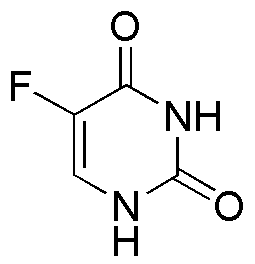5-Fluorouracil is widely utilized in research focused on
- Cancer Treatment: This compound is a key chemotherapeutic agent used to treat various types of cancer, including colorectal and breast cancer. It works by inhibiting DNA synthesis, which helps to slow down or stop the growth of cancer cells.
- Topical Applications: In dermatology, it is used in topical formulations to treat skin cancers and precancerous conditions like actinic keratosis. Its localized application minimizes systemic side effects.
- Research in Molecular Biology: 5-Fluorouracil is often employed in laboratory settings to study cellular responses to DNA damage and repair mechanisms, providing insights into cancer biology.
- Combination Therapies: It is frequently used in combination with other chemotherapeutic agents to enhance treatment efficacy, allowing for tailored cancer treatment plans that can improve patient outcomes.
- Pharmaceutical Development: The compound serves as a model for developing new drugs targeting similar pathways, aiding pharmaceutical researchers in designing more effective cancer therapies.
General Information
Properties
Safety and Regulations
Applications
5-Fluorouracil is widely utilized in research focused on
- Cancer Treatment: This compound is a key chemotherapeutic agent used to treat various types of cancer, including colorectal and breast cancer. It works by inhibiting DNA synthesis, which helps to slow down or stop the growth of cancer cells.
- Topical Applications: In dermatology, it is used in topical formulations to treat skin cancers and precancerous conditions like actinic keratosis. Its localized application minimizes systemic side effects.
- Research in Molecular Biology: 5-Fluorouracil is often employed in laboratory settings to study cellular responses to DNA damage and repair mechanisms, providing insights into cancer biology.
- Combination Therapies: It is frequently used in combination with other chemotherapeutic agents to enhance treatment efficacy, allowing for tailored cancer treatment plans that can improve patient outcomes.
- Pharmaceutical Development: The compound serves as a model for developing new drugs targeting similar pathways, aiding pharmaceutical researchers in designing more effective cancer therapies.
Documents
Safety Data Sheets (SDS)
The SDS provides comprehensive safety information on handling, storage, and disposal of the product.
Product Specification (PS)
The PS provides a comprehensive breakdown of the product’s properties, including chemical composition, physical state, purity, and storage requirements. It also details acceptable quality ranges and the product's intended applications.
Certificates of Analysis (COA)
Search for Certificates of Analysis (COA) by entering the products Lot Number. Lot and Batch Numbers can be found on a product’s label following the words ‘Lot’ or ‘Batch’.
*Catalog Number
*Lot Number
Certificates Of Origin (COO)
This COO confirms the country where the product was manufactured, and also details the materials and components used in it and whether it is derived from natural, synthetic, or other specific sources. This certificate may be required for customs, trade, and regulatory compliance.
*Catalog Number
*Lot Number
Safety Data Sheets (SDS)
The SDS provides comprehensive safety information on handling, storage, and disposal of the product.
DownloadProduct Specification (PS)
The PS provides a comprehensive breakdown of the product’s properties, including chemical composition, physical state, purity, and storage requirements. It also details acceptable quality ranges and the product's intended applications.
DownloadCertificates of Analysis (COA)
Search for Certificates of Analysis (COA) by entering the products Lot Number. Lot and Batch Numbers can be found on a product’s label following the words ‘Lot’ or ‘Batch’.
*Catalog Number
*Lot Number
Certificates Of Origin (COO)
This COO confirms the country where the product was manufactured, and also details the materials and components used in it and whether it is derived from natural, synthetic, or other specific sources. This certificate may be required for customs, trade, and regulatory compliance.


